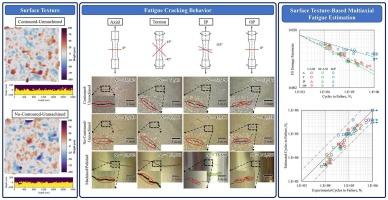Multiaxial fatigue behavior and modeling for additive manufactured Ti-6Al-4V: The effect of surface texture
IF 6.8
2区 材料科学
Q1 ENGINEERING, MECHANICAL
引用次数: 0
Abstract
The rough surface texture of unmachined specimens produced by the laser powder bed fusion (L-PBF) technique can significantly reduce their fatigue strength. Accurate measurement of surface topography is essential for obtaining reliable surface roughness parameters to enable quantitative comparisons and fatigue life estimations. A hybrid surface roughness parameter, previously proposed for uniaxial fatigue scenarios, linking surface texture with the fatigue strength of L-PBF materials, has been adopted to estimate the effect of surface texture on the multiaxial fatigue behavior of L-PBF Ti-6Al-4V alloy. Surface topographies are thoroughly measured using an optical microscope and X-ray computed tomography, and the outcomes of the two techniques are compared. Multiaxial fatigue results are analyzed using three different fatigue models. The surface texture-based fatigue life estimation approach is then combined with these three models to estimate the fatigue strength of different surface texture conditions under multiaxial loading. The results indicate that while the surface texture-based fatigue life estimation approach was originally developed for uniaxial loads, it could be extended to torsion as well as combined axial-torsion stress states. It was also found that the approach works only when the appropriate multiaxial fatigue life estimation model, consistent with the failure mechanism of the material, is utilized.

增材制造Ti-6Al-4V的多轴疲劳行为及建模:表面织构的影响
激光粉末床熔合(L-PBF)技术制备的未加工试样表面粗糙的织构会显著降低试样的疲劳强度。精确测量表面形貌对于获得可靠的表面粗糙度参数至关重要,以便进行定量比较和疲劳寿命估计。采用一种混合表面粗糙度参数,将L-PBF材料的表面织构与疲劳强度联系起来,用于估计表面织构对L-PBF Ti-6Al-4V合金多轴疲劳行为的影响。使用光学显微镜和x射线计算机断层扫描彻底测量表面形貌,并比较了两种技术的结果。采用三种不同的疲劳模型对多轴疲劳结果进行了分析。然后,将基于表面织构的疲劳寿命估计方法与这三种模型相结合,对多轴载荷下不同表面织构条件下的疲劳强度进行估计。结果表明,基于表面织构的疲劳寿命估计方法最初是针对单轴载荷而开发的,但它可以扩展到扭转以及轴扭复合应力状态。研究还发现,该方法只有在采用符合材料失效机理的适当的多轴疲劳寿命估计模型时才有效。
本文章由计算机程序翻译,如有差异,请以英文原文为准。
求助全文
约1分钟内获得全文
求助全文
来源期刊

International Journal of Fatigue
工程技术-材料科学:综合
CiteScore
10.70
自引率
21.70%
发文量
619
审稿时长
58 days
期刊介绍:
Typical subjects discussed in International Journal of Fatigue address:
Novel fatigue testing and characterization methods (new kinds of fatigue tests, critical evaluation of existing methods, in situ measurement of fatigue degradation, non-contact field measurements)
Multiaxial fatigue and complex loading effects of materials and structures, exploring state-of-the-art concepts in degradation under cyclic loading
Fatigue in the very high cycle regime, including failure mode transitions from surface to subsurface, effects of surface treatment, processing, and loading conditions
Modeling (including degradation processes and related driving forces, multiscale/multi-resolution methods, computational hierarchical and concurrent methods for coupled component and material responses, novel methods for notch root analysis, fracture mechanics, damage mechanics, crack growth kinetics, life prediction and durability, and prediction of stochastic fatigue behavior reflecting microstructure and service conditions)
Models for early stages of fatigue crack formation and growth that explicitly consider microstructure and relevant materials science aspects
Understanding the influence or manufacturing and processing route on fatigue degradation, and embedding this understanding in more predictive schemes for mitigation and design against fatigue
Prognosis and damage state awareness (including sensors, monitoring, methodology, interactive control, accelerated methods, data interpretation)
Applications of technologies associated with fatigue and their implications for structural integrity and reliability. This includes issues related to design, operation and maintenance, i.e., life cycle engineering
Smart materials and structures that can sense and mitigate fatigue degradation
Fatigue of devices and structures at small scales, including effects of process route and surfaces/interfaces.
 求助内容:
求助内容: 应助结果提醒方式:
应助结果提醒方式:


